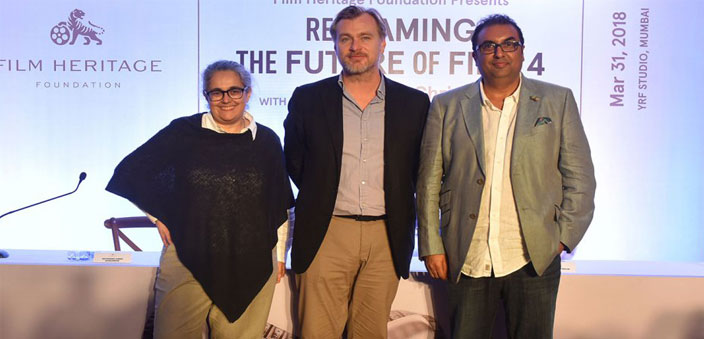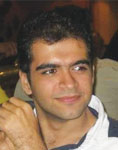The first of April is celebrated as April Fool’s day the world over. It is a day when pranks are at large, people are wary of any information that comes to them, and they doubt literally everyone. So it is but natural when it was announced that the celebrated filmmaker Christopher Nolan would be coming to Mumbai for a conversation and a discussion on 1 April, people had their doubts. Was it really Nolan who was coming? The man who made the Dark Knight trilogy, Inception, Interstellar and Dunkirk? I was one among those fools who went searching for the maestro. But this 1 April was an April Fool’s of a different kind. Christopher Nolan came and he took the stage of NCPA to discuss something very close to his heart: The preservation of film.
Nolan was not alone in his endeavour, for he was accompanied by artist Tacita Dean, and Shivendra Singh Dungarpur, founder of the Film Heritage Foundation. The entire discussion began with the words nostalgia and passion. Nolan and Dean both expressed displeasure over the fact that their passion for celluloid was always dismissed as ‘nostalgia’. What emerged in their voice and their words is a purpose for a form of cinema which is now considered obsolete. The digital world has taken over film so strongly that their battle seems weak. If one were to add a bit of perspective to this, most of today’s filmmakers consider celluloid film archaic, almost like stone age tools. Now why would you create film when it can so simply and meticulously be transferred digitally? This question is the principal question that the artist and the craftsman came to clarify, and they did with a certain purpose which can’t just be dismissed as ‘nostalgia.’
The voices of Nolan and Dean
But first let’s consider the two entities that were invited to speak. Nolan differentiated between himself and Tacita Dean very clearly. He classified her as an artist and himself as a craftsman. What is the difference between the two? Well, Nolan doesn’t just create his work for his vision, he creates his work for mass consumption. He has to sell his work and that work needs to have takers, the ‘money men’ of the world. Dean on the other hand has worked extensively with 16 mm films. She was the nominee for the Turner award in the year 1998 and she romantacises the idea of film. Listening to her speak about cinema is like listening to poetry, for she has such beautiful things to say about the process. Her descriptions about how her films are cut, literally with hand in this world of digital, is the very verse which might revive celluloid. Her passion resonated with the craftsman Nolan’s voice as they bought their visions to the NCPA stage on 1 April.
But the craftsman and the artist found the company of a third on the stage, who is closer home. Shivendra Singh Dungarpur is a filmmaker, archivist and restorer, who is in a way the ‘Übermensch’ against the force majeur that attempts to destroy celluloid in India. His passion has led him to create the documentary titled Celluloid Man, a work that explores the works of legendary Indian archivist P.K. Nair.
The three sat and discussed this topic for an hour and the audience listened intently. The fanboys and fangirls who came just to see their deity in flesh and blood heard them, tuning into them and their words. The discussion was titled ‘Reframing the future of film’. What had preceded the discussion were two nights of film screenings of Nolan’s films in the medium he intended to make the film in, 35mm and 70 mm film. He also had discussions with industry stalwarts in the Yash Raj Studios.
But what is the fuss about? Why save the celluloid? It’s not going to grow extinct, will it? And even if it does it isn’t like an animal is going to become extinct or a race is going to die, is it? After all the number of films being made and the number of TV shows being made is ever increasing, content as we know is growing, then why save these celluloid formats that caused so many problems to so many directors in the past?
Why save the celluloid?
Well, the reason is, it is a language which is very different from the language of digital. As Nolan puts it there is no reason one should change from celluloid to digital, the images are brilliant, the technology is available for the last one hundred years and this is the only format in which film can be preserved. A library of digital cinema has no meaning, film is the only way that cinema can survive. Tacita Dean agreed unequivocally and encouraged museums to preserve film. Unfortunately, not many initiatives exist in India that preserved film in the way the filmmaker intended it to be made. That is precisely the only argument the three thinkers were making. They never once spoke about discontinuing digital, nor criticised it. They just wanted this tool to exist, so that people have the choice to watch it in the way the film-maker wanted it to be seen.
There were arguments that the film may get destroyed, or scratches might be observed on the film in time. But to that argument Nolan was categoric that it still would be the closest to what the filmmaker wanted. There should be methods to restore film, and those should be used in case such things happen, but just because such things happen it doesn’t mean that one should not preserve film, that idea is absurd. Also digital will always need a computer, a software and relevant other tools to watch, but film just needs a little light and the story unfolds, hence film is a much more dependable form of preservation. To the question that film is expensive, Nolan and Dean replied why should anyone care how expensive the film should be? It should only be the call of the filmmaker as to whether she finds that money worth spending, and it’s the right of the filmmaker to fight for the medium they believe in. The expense question is a detailed one, and a complicated one, which needs many factors to be answered and not just one. Dungarpur did add that he even took Nolan to ‘Chor Bazaar’ to get an instrument for a few thousand rupees!
The question of digital and analog rose the main question of availability, and believe it or not, in the audience sat the Kodak CEO Jeff Clarke who eventually joined the trio of Nolan, Dean and Dungarpur and was grilled for a good few minutes by Dean to the quintessential question. Those minutes were like an interrogation by the artist and a surrender by the merchant. He eventually relented by launching new equipment, and promising that the future of film isn’t bleak, for there will be support from the industry to create mechanisms that will support analog.
To quote filmmaker Sai Pawar (director of the film Color of War) “It is true that with the turn of the century we are seeing the upheaval of the digital era and face the fear of film becoming extinct like pagers and dinosaurs. And for us filmmakers it is important to understand that regardless of film or digital, cinema at its core is visual poetry, a way to tell stories that affect the viewer in some way on a psychological and philosophical level, and to create that effect the artist must be equipped with all the tools. What Nolan and Dean are doing is to pave a way for the filmmakers of today and tomorrow to have film available in our toolkit to tell stories. Quite simply put the digital sensor do not have the tangibility and psychological effect that film has on the sub-conscious mind of viewer or vice-a-versa. It’s not about telling the story, it’s about telling the story a certain way. Would Rembrandt be Rembrandt if he painted using a computer?”
The arguments and the questions went on, the ‘Q & A’ opened to a massive crowd where each one was screaming, shouting to ask one question to their deity, their craftsman, and in the distance, I sat in the last row looking at the artist, how she sat silently looking into the crowd. I noticed the ticket I had, it had a piece of film attached, a small strip. I also noticed something was written on it. I focused the light on it, and saw the words, “Film, is a beautiful physical and robust medium that keeps the light within its fabric and holds in its emulsion the imprint of time. It is our cultural and historical memory: a place of imagination, poetry, art and life.” I saw through it and found the artist, the craftsman, and the archivist, distinctly placed inside its frame. I walked away silently, all my questions were already answered.


 [/column]
[/column]